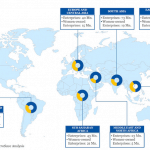The Benefits – And Downsides – of ‘Buy Now, Pay Later’: Is it Enhancing or Hindering Financial Inclusion?
Buy now, pay later (BNPL) schemes offer consumers immediate possession of goods, which they pay for over time via (usually interest-free) installments. BNPL is similar to layaway (also called “lay-by”), which also involves installment payments – traditionally offered at the point of sale by retailers. But there are differences. With layaway services, the retailer bears the transaction and financial risks and manages the stock inventory, with the item generally remaining at the store. The consumer must first make all timed payments before taking the item home.
BNPL is often the only practical credit option for many people in emerging economies – especially those with limited or no access to financial services. As such, these schemes can offer a path for expanding financial inclusion, along with the inherent benefit of giving consumers access to goods that may otherwise have been unaffordable to them. However, easier access to credit also presents some pitfalls – particularly over-indebtedness – which providers should be careful to avoid.
Below, we’ll discuss the growth of BNPL, the benefits and risks associated with it, and some key practices that can help maximize its positive impacts on consumers while avoiding any potential downsides.
The Growth – And Appeal – of Buy Now, Pay Later
The COVID pandemic resulted in a surge in BNPL as more people shifted to online shopping. Klarna, Afterpay and Affirm, the three biggest BNPL providers globally, are reporting year-on-year growth ranging from 46% to 104%. It is no wonder that more players are entering the BNPL market – a group that will soon include Apple, whose partnerships with online merchants and retail marketplaces will enable their products to be embedded into Apple’s digital platforms to provide seamless consumer journeys with 24/7 access.
In 2021, BNPL accounted for 2.9% of worldwide e-commerce transaction value, which equates to around US $157 billion. This percentage is expected to increase to 5.3% by 2025, according to WorldPay’s 2022 Global Payments Report. Venture capital has flooded into BNPL companies, and this – combined with the sector’s anticipated growth – could result in a significant disruption to the credit card and loans industry.
The appeal of BNPL is understandable. In addition to providing typically free financing, the application process is easy, with barely any credit check involved, limited-to-no human intervention – and nearly instantaneous approval. While approval criteria may vary, customers may still be eligible even if they have poor credit or no credit. Likewise, consumer possession is quick, with buyers generally able to take home the product at the time of purchase. In addition, with a fixed amount due each payment period and a deadline for settling the debt, some argue that BNPL simplifies budgeting for expensive, quality-of-life products, such as mattresses, washing machines and mobile phones. And research shows that some consumers make informed choices to use buy now, pay later options to manage their current cash flow by deferring payment, or avoiding paying interest charges, and using credit cards or loans for larger purchases. By providing consumers with a choice on how to spend and allocate their money and which credit products to use, BNPL offers a fast, easy and convenient approach to financing that can make new products accessible – even to lower-income customers and to younger, Millennial and Gen-Z customers.
It also appeals to retailers, who are paid upfront by the BNPL providers (minus their fee). It can expand their customer bases, boost sales and order values, encourage repeat purchasing, and increase customer loyalty.
The Risks and Challenges of BNPL
Yet despite these benefits, BNPL has met with suspicion and concern. This is unsurprising, as the practice can be seen to promote instant gratification and a “buy now, worry later” mentality. Concerns have also been raised about whether customers view BNPL as credit, or instead associate it with payment technologies like Google Pay, Apple Pay or Amazon One Click. As a result, these consumers may apply lax scrutiny in their decision-making process for BNPL purchases, when compared to the more cautious approach they take when considering other credit products.
By providing fast and easy access to credit, BNPL can also be seen as allowing or encouraging customers to overextend themselves and purchase more than they need or can afford. What’s more, while most BNPL providers charge neither interest nor penalty fees for late payment, others opt to do so. This has the potential to trip up customers who assume all BNPL companies operate with no fees without reading the small print, and it can lead to unexpected penalty fees being levied on top of the amount borrowed, creating a spiral effect on the debt and making it difficult to repay. It is also possible to make multiple BNPL purchases with different providers, since little (if any) checks are made between providers. This allows customers to amass a larger debt across multiple BNPL providers, which can become challenging for the customer to track and repay.
These practices illustrate how BNPL could lead to over-indebtedness, particularly for vulnerable groups with low and/or unpredictable incomes and poor understanding of the risks. In the U.K., around a third of customers using BNPL products report that repayments have become unmanageable. These same households are also less likely to have a credit card or access to loans, and are more likely to face financial challenges that make access to credit critical. Becoming trapped in a cycle of debt and being denied access to credit can financially exclude customers for lengthy periods of time.
Although BNPL providers conduct affordability assessments, these purchases are rarely underwritten using traditional credit bureaus. And not all BNPL providers report on-time payments to the credit bureaus. This makes it difficult for these providers to understand a consumer’s complete debt picture, and for consumers to use BNPL payments to build their credit history. This hinders inclusion, rather than supporting it by facilitating a credit history for customers.
Finally, some providers have faced regulatory challenges that have complicated their efforts to introduce BNPL offerings. For example, Kenya’s Safaricom, in partnership with Equity Bank, had begun advertising their new BNPL product, Faraja, which aims to allow customers to spend up to 100,000 shillings and pay later with zero interest. But the Central Bank of Kenya asked them to stop the release just hours before its planned launch. The Central Bank is currently reviewing the product and its launch is on hold, but it nonetheless remains one to watch.
Best Practices for Responsible BNPL
However, even with these challenges, responsible BNPL can expand financial inclusion. Best practices such as the following can help.
Using BNPL to help consumers build a credit history: Regulators and consumer advocacy groups need to encourage BNPL providers to report BNPL loan information to credit bureaus, and to build a better credit information market. This is happening in some markets: In the U.S., for example, Equifax was the first consumer reporting agency to announce a formalized process for including BNPL payment data on traditional U.S. credit reports. This change was made because typical credit scoring models were not initially built to incorporate BNPL data. This new reporting could play an essential role in other financial providers’ affordability assessments, as it will help lenders better decide whether to open a new line of credit for customers, while also rewarding them for paying on time. A history of on-time payments can help build customers’ credit scores and provide them with more affordable financing options in the future.
Promoting responsible lending through customer affordability assessments: The outcome of an affordability assessment should help determine the amount and terms of the finance a customer is offered, while also helping to ensure that the BNPL amount is manageable. Without a proper affordability check, the lender may give a customer a loan that’s larger than they need, or that they can’t pay back.
Promoting responsible advertising: Often, BNPL advertising focuses on consumer aspirations for a certain lifestyle, which can compel impulsive decisions that may not be in the customers’ best interests. There are efforts in the industry to push back against this tendency: For instance, in December 2020, the U.K.’s Advertising Standards Agency instructed the Swedish fintech Klarna to remove four advertisements linking its BNPL services with “lifting or boosting mood” during COVID, and issued guidance on how it could advertise its delayed payment services.
Ensuring terms and conditions are easy to understand: It is important to convey this information not only at the point of sale, but also by communicating with consumers before and after their purchases. One criticism of BNPL is that the process is so frictionless that some consumers find themselves in unmanageable debt without even realizing it. Greater emphasis on providing long-term debt advice can help consumers understand both the BNPL product and their own financial situation, so they can make informed decisions.
Adapting existing regulation: BNPL may not specifically be mentioned or covered in current regulations and laws around credit, with the loophole often being due to the fact that no interest is levied. However, regulation around digital credit and consumer protection is likely to exist and can be made applicable. Regulators should consider amending relevant regulation and policy to include BNPL practices. BNPL providers believe that a balance should be considered, allowing them to continue to innovate and boost inclusion without being stifled with lengthy regulation – while also protecting the interests of customers.
Promoting self-regulation: In the absence of regulations or regulatory amendments around BNPL, some jurisdictions have launched codes of practice, which are voluntary in the absence of regulation. For example in Australia, an early adopter where over one-third of citizens have used BNPL as a payment method, the Australia Finance Industry Association in March 2021 launched the voluntary AFIA Buy Now Pay Later Code of Practice for BNPL product providers. Singapore is developing a similar voluntary code of practice.
There is no denying the appeal of BNPL to people who want to enjoy popular consumer products, but who may not have access to credit to enable these purchases. Buy now, pay later payment options have the power to bring new products and greater financial inclusion to millions – but with that power comes the need for responsibility. By focusing on clarity, transparency and customers’ financial inclusion and access, BNPL providers can boost their own success and that of retailers, while also avoiding negative outcomes among their customers.
Sarah Corley is CEO at the Alliance of Digital Finance Associations and Divisional Director at Digital Frontiers; Lotte Schou Zibell is Advisor, Office of the Director General, South Asia Department at the Asian Development Bank.
Photo credit: Brian Evans.
- Categories
- Finance, Technology, Telecommunications



